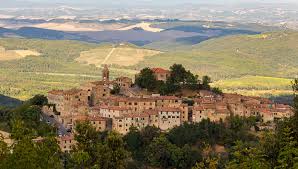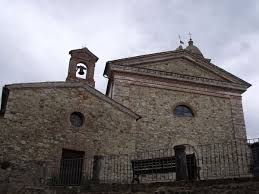Pari è un paese di origini antichissime, è situato su un’altura ed è circondato da colli che hanno quasi la stessa altezza, ricoperti di boschi e di cespugli di ginestra.

Queste piante, un tempo, furono utili per alcune attività lavorative per la popolazione. I Parigiani, cioè gli abitanti di Pari, sono detti “ginestrai” perché le donne si dedicavano alla lavorazione della ginestra con la quale facevano i tessuti per realizzare la biancheria di casa, che veniva finemente impreziosita dalle ricamatrici. Nota per la sua bravura era Caterina, che diventò maestra in quest’arte. Visto dall’alto, questo borgo antico assomiglia a un aquilone, che, stanco di volare, si è appoggiato al suolo per riposarsi.
Un tempo Pari era un castello e apparteneva ai conti Ardengheschi. Oggi, dell’antico maniero rimangono due porte di accesso, una detta Porta Senese e l’altra Porta Grossetana.
Il turista che arriva a Pari nota subito l’architettura medievale con le vie molto strette, con le case una vicina all’altra unite in un abbraccio. Tutte sono in pietra ornate con ferro battuto e vasi di fiori.
Davanti alla chiesa di San Biagio, patrono del paese, su un’antica pavimentazione fatta con mattoni messi a coltello, si trova un pozzo che un tempo garantiva l’acqua agli abitanti.
La chiesa, anch’essa costruita in pietra, è stata ristrutturata nel 1400 circa con pietre provenienti da San Giorgio in Valoria, un tempio pagano vicino al Lago Fabio. All’interno della chiesa sono conservate delle opere d’arte risalenti al quattrocento e al seicento.
A Pari i punti di ritrovo degli abitanti sono le piazze nelle quali si svolgono le feste paesane: sagra della salsiccia, cena nel borgo, la festa del Santo patrono, il carnevale. Le più importanti sono Piazza della Chiesa e Piazza Castelfidardo. Un tempo quest’ultima era il luogo dove veniva disputata una partita a squadre con una palla fatta di cuoio e segatura, cucita rigorosamente a mano, il gioco si chiamava Palla eh!.
Sulla sommità del paese c’è un palazzo che un tempo fu il Palazzo della Giustizia, poi diventò una scuola ed ora è un centro culturale. Dietro a questa grande costruzione c’è un’ampia piazza dalla quale si può ammirare uno splendido panorama, una grande finestra che si affaccia sulla campagna circostante.
Percorrendo le vie del paese, osservando con attenzione tutti i particolari, si possono vedere una parte di pavimentazione originaria del piccolo borgo, realizzata con le pietre focaie, il Palazzo del Podestà, che un tempo comandava il paese, e il Vecchio Spedale, luogo dove i pellegrini e i viandanti potevano trovare riparo e un luogo di riposo.
Pari mantiene ancora inalterata questa accoglienza nei confronti del turista, offrendogli buon cibo, buon vino, ottimo olio di oliva, pace e tranquillità in questi luoghi ameni e ricchi di storia.

Looking at this village from the top, it looks like a kite, which tired of flying, is leaning on the ground to rest.
Pari is a village of ancient origins surrounded by hills covered with woods and ginestre (brooms). These plants, once were used for many working activities by locals. Parigiani which are the inhabitants of Pari, are called ginestrai as the women used to process the brooms with which they made fabrics for the house linen then embellished by the embroiderers. Very famous was Caterina, a woman who mastered this art so well that she became a teacher of it.
During the medieval time, Pari was a castle belonging to the Ardengheschi counts; today only two gates of the ancient manor are left: Porta Senese and Porta Grossetana. The tourist, who arrives in Pari, immediately notes the medieval architecture: very narrow streets and houses made of stones, decorated with wrought iron and flower pots; they are so close to each other that seem hugging.
In front of San Biagio’s church, the patron saint of the village, on a former paving made with hand-cut bricks, there is a well that guaranteed water to the inhabitants. The church was restored in the fifteenth century with stones brought to Pari from San Giorgio in Valoria, a pagan temple near the lake Fabio. Inside the church there are well-preserved works of art dating back to the fifteenth and seventeenth centuries.
A meeting point for the inhabitants are the squares in which the village festivals are held: Sausage Festival, The Borough Dinner Festival, the Saint Biagio’s day and Carnival. The most important squares are Church square and Castelfidardo square where in the past an ancient game named Palla, eh! was played using a hand-sewn ball made of leather and sawdust.
In the high town there is the Palace of Justice which firstly became a school and now is a cultural center. Behind this large building there is a square from which you can admire a splendid panorama like a large window overlooking the countryside. Walking through the streets of the village, it can be also admired: a part of the original paving of the village made with flints, Palazzo del Podestà, a place where the village was ruled and the Old Spedale, where pilgrims and hikers find shelter and a place of rest.
Pari welcomes tourists, offering good food, good wine, excellent olive oil, peace and tranquility in a beautiful place full of history.

